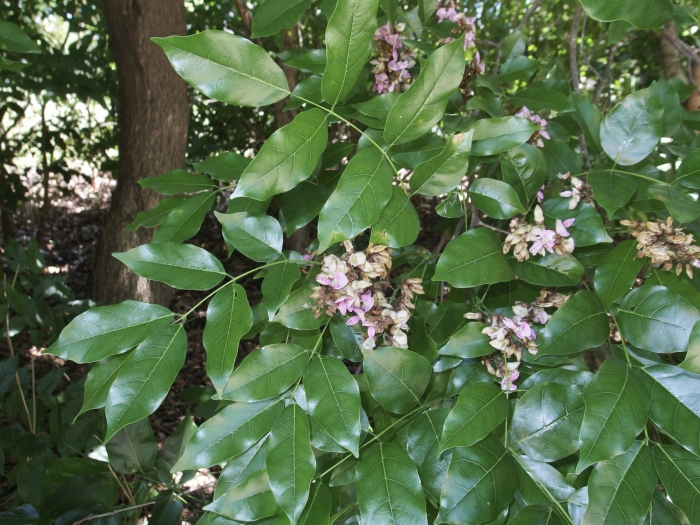Indian Beech
(Pongamia pinnata)
Indian Beech (Pongamia pinnata)
/
/

Sue Carnahan
CC BY 4.0
Image By:
Sue Carnahan
Recorded By:
Copyright:
CC BY 4.0
Copyright Notice:
Photo by: Sue Carnahan | License Type: CC BY 4.0 | License URL: http://creativecommons.org/licenses/by/4.0/ | Rights Holder: Sue Carnahan | Publisher: iNaturalist | Date Created: 2022-10-20T10:22:16-07:00 |























Estimated Native Range
Summary
Pongamia pinnata, commonly known as Indian Beech or Pongame Oiltree, is a deciduous legume tree native to coastal and riverine areas of eastern and tropical Asia, northern Australia, and some Pacific islands. It typically grows to a height of 49-82 feet with a broad, spreading canopy that can be equally wide. The tree’s appearance is characterized by its smooth, light brown bark and elongated leaflets, which are arranged in pinnate fashion. It produces clusters of fragrant, purple or white flowers during the spring, followed by seed pods containing oil-rich seeds. The flowers are moderately showy and attract pollinators.
Indian Beech is valued for its shade, ornamental flowers, and its adaptability to a range of soil types, including poor and saline soils. It is often used for reforestation projects, soil erosion control, and as a windbreak due to its deep root system. In cultivation, it requires full sun to part shade, moderate watering, and well-drained soils. It is also known for its potential in biofuel production, as the seeds yield a non-edible oil that can be processed into biodiesel. However, gardeners should be aware of its potential invasiveness outside its native range and its susceptibility to pests like the Pongamia webworm.CC BY-SA 4.0
Indian Beech is valued for its shade, ornamental flowers, and its adaptability to a range of soil types, including poor and saline soils. It is often used for reforestation projects, soil erosion control, and as a windbreak due to its deep root system. In cultivation, it requires full sun to part shade, moderate watering, and well-drained soils. It is also known for its potential in biofuel production, as the seeds yield a non-edible oil that can be processed into biodiesel. However, gardeners should be aware of its potential invasiveness outside its native range and its susceptibility to pests like the Pongamia webworm.CC BY-SA 4.0
Plant Description
- Plant Type: Tree
- Height: 49-82 feet
- Width: 30-39 feet
- Growth Rate: Moderate, Rapid
- Flower Color: Pink
- Flowering Season: Spring, Summer
- Leaf Retention: Deciduous
Growth Requirements
- Sun: Full Sun
- Water: Medium
- Drainage: Fast, Medium
Common Uses
Bee Garden, Bird Garden, Drought Tolerant, Erosion Control, Showy Flowers, Street Planting
Natural Habitat
Native to coastal and riverine areas of eastern and tropical Asia, northern Australia, and some Pacific islands
Other Names
Common Names: Pongam, Karanj, Poonga-Oil-Tree, Indian Beech Tree
Scientific Names: , Pongamia pinnata, Cajum pinnatum, Cytisus pinnatus, Galedupa pinnata, Galedupa pungum, Millettia pinnata, Pongamia glabra, Pongamia pinnata, Pongamia pinnata var. typica,
GBIF Accepted Name: